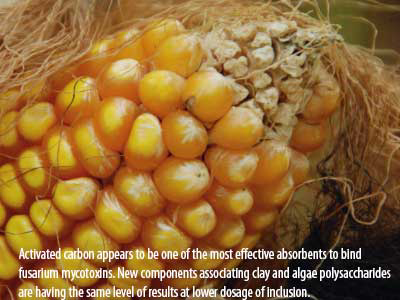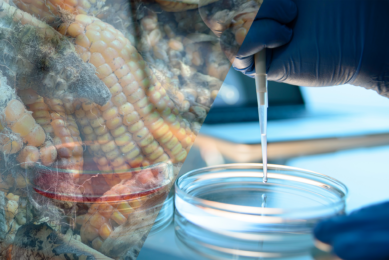Mycotoxin detoxification: Science vs marketing

The use of mycotoxin detoxifying agents in feed and optimum farm management practice is the only possible method to reduce mycotoxins and their impact in the food chain. This will reduce problems associated with animal performance and human health. Results obtained in the trials prove that the choice of an effective detoxifying agent is a key factor in controlling mycotoxins.
By Maria Angeles Rodriguez and Julia Laurain, Olmix and Ray Rochester and Clare Walsh, Vetsonic
Mycotoxins are secondary metabolites from specific mould strains. They are potentially toxic substances that can affect health when ingested. The toxic effects of mycotoxins can vary depending on their chemical structure, concentration, exposure, animal species, animal health status and combination of different mycotoxins.
International trade, climate change and a better control as well as a better knowledge of these substances have created a higher awareness of the risks they pose to health and livestock performance. In the last report (EMAN Spring 2012), in which raw materials, animal feeds and other feed ingredients collected during 2011 were analysed, they found mycotoxin presence in most of the 4,327 samples. 40% of samples were contaminated in zearalenone, 50% were contaminated in deoxynivalenol, and 51% were contaminated in fumonisin. We tend to think that this situation is just affecting tropical and subtropical regions but the fact is that this contamination affects every region in the world, even Europe. If we focus on European results, a total of 1,519 samples originating from Europe showed that fusarium mycotoxins were of great concern. In Central Europe, 41%, 64% and 51% of all samples tested positive for ZON, DON and FUM. Afla, FUM and OTA occurrences were higher in Southern Europe with 33%, 56% and 41% of samples testing positive, respectively (Central Europe: 19%, 51% and 20% for Afla, FUM and OTA, respectively). All mycotoxins investigated could be found in Europe and 65% of all samples showed the presence of more than one mycotoxin.
More damage than expected
The probability of having a multicontamination on one raw material sample is very high, as shown in Figure 1. In fact, favourable conditions for the development of one mould often permits the development of other moulds too, in addition one mould can produce a different type of mycotoxin. Research suggests that toxic effects can occur at much lower mycotoxins contamination than those described in the bibliography: it’s the synergic effect. A recent study run by Isabelle Oswald (2011) demonstrated the synergic effect between DON and fumonisin in the intestine. She concluded that fumonisin obstructs the renewal of epithelial cells when they have been damaged by DON.
Dr Johanna Fink-Gremmels, from Utrecht University, stated that the mycotoxin detoxification ability in dairy cow rumens is lower than believed. Even more, these mycotoxins have a harmful effect on the rumen microbes, provoking unbalances in ruminal flora that can lead to chronic diseases, digestive problems and acidosis.
In a German study, Keese et al looked at the ruminal patterns influenced by the proportion of concentrate in the feed ration, with and without fusarium toxin-contaminated in the diet. Feeding a total mixed ration with 50% concentrate and a mean DON concentration of 5.3 mg/kg dry matter to 13 German Holstein cows in early lactation (Myco group) resulted in alterations in the ruminal fermentation patterns: alteration of the volatile fatty acids balance followed by drop of pH values, critical for developing sub acute acidosis. This could indicate a switch in the microbial community due to direct effects and/or indirect effects of the fusarium infection on the physical/chemical properties of the infected cereal on ruminal microbes.
Efficacy of detoxifying agents
Demonstration of the effectiveness of a potential mycotoxin detoxifying agent in contaminated feed is often primarily conducted under in vitro conditions. Classical in vitro systems used for that purpose are simple but very far from the natural in vivo conditions. Important factors in relation to the digestion and the fate of feed compounds during passage through the gastrointestinal tract are the composition and pH of gastric and intestinal contents, the gastrointestinal transit conditions, the activity of bio-chemicals (enzymes) and of the intestinal micro flora in the gastrointestinal tract. The activities of those factors through the gastrointestinal tract are dynamic processes. Therefore, these processes cannot be simulated in static in vitro models. To demonstrate in the most repeatable and reliable conditions the efficacy in vitro of a sequestrant/ chelator material, the TNO TIM-1 in vitro gastrointestinal model can be used (www.tno.nl).
The TNO in vitro gastrointestinal models simulates the successive dynamic processes in the stomach and small intestine (TIM-1) and in the large intestine (TIM-2). These models are unique tools to study the fate of compounds during passage through the gastrointestinal tract. As the main absorption site for mycotoxins is the proximal part of small intestine, it is most effective to test these products in TIM-1 system, the TNO dynamic, multicompartmental system of the stomach and small intestine. This computer controlled model simulates the successive dynamic conditions in the gastric compartment and in the three successive compartments of the small intestine.
Activated carbon
In 2004, Döll (Table 1) showed that zearalenone is not that difficult to bind comparing to other fusarium mycotoxins. Thus, the challenge for a mycotoxin detoxifying agent is to reduce the absorption of mycotoxins like trichotecens and fumonisine. Dr Giussepina Avantaggiatto, from CNR Institute of Sciences of Food Production (ISPA) in Italy has run several trials using this system to evaluate the efficacy of several commercial binding agents and substances potentially useful as chelating agents. Only activated carbon was shown to be effective with binding capacities of 35.1 μmol and 8.8 μmol DON and NIV/g adsorbent, respectively, calculated from the adsorption isotherms. The study then used the dynamic laboratory model (TIM) to evaluate the small-intestinal absorption of DON and NIV and the efficacy of activated carbon in reducing the relevant absorption. The in vitro intestinal absorptions of DON and NIV were 51% and 21% respectively. Most adsorption occurred in the jejunal compartment for both mycotoxins. The inclusion of activated carbon resulted in a significant reduction in the intestinal mycotoxin absorption. At 2% inclusion level, the absorption with respect to the intake was lowered from 51% to 28% for DON and from 21% to 12% for NIV. Using information from previous studies it can be concluded that activated carbon appears to be one of the most effective mycotoxin adsorbents. All other commercial products showed poor efficacy in their capacity of binding fusarium mycotoxins. In practice, the use of activated carbon in animal production has some limitations. High concentrations of activated carbons (> 0.5%, w/w) should be avoided in order to minimise the risk of nutrient adsorption as well as an impairment of the caloric/ nutritional value of the feed.
New technologies
New technologies that are currently available allow the modification of some materials which can then be used in animal nutrition and mycotoxin binding. Specific technologies can modify clay structure at a nanometric scale, increasing the interlayer space and thus modifying the adsorption capacity. This modification can be done using a natural agent such as algae polysaccharides. Ulvans, polyanionic polysaccharides present in the green algae, are sulphated xyloramhnoglucoromannans. They are good chelating agents and when reacting with calcium ions present in the interlayer space of montmorillonite they become really rigid, and form a matrix similar to the structure of active charcoal. The adsorption of mycotoxins in this new material is a complex mechanism involving CEC of montmorillonite, the polyanionic structure of ulvans and the “microtubular” structure formed in the interlayer space. When testing this new material using the TIM-1 system, results were even better than those reached by activated carbon. In addition, the use of this product did not inhibit the digestibility of proteins and carbohydrates, or impair the bioaccessibility of vitamins B1 and B2.
[Source: Mycotoxin Special]











